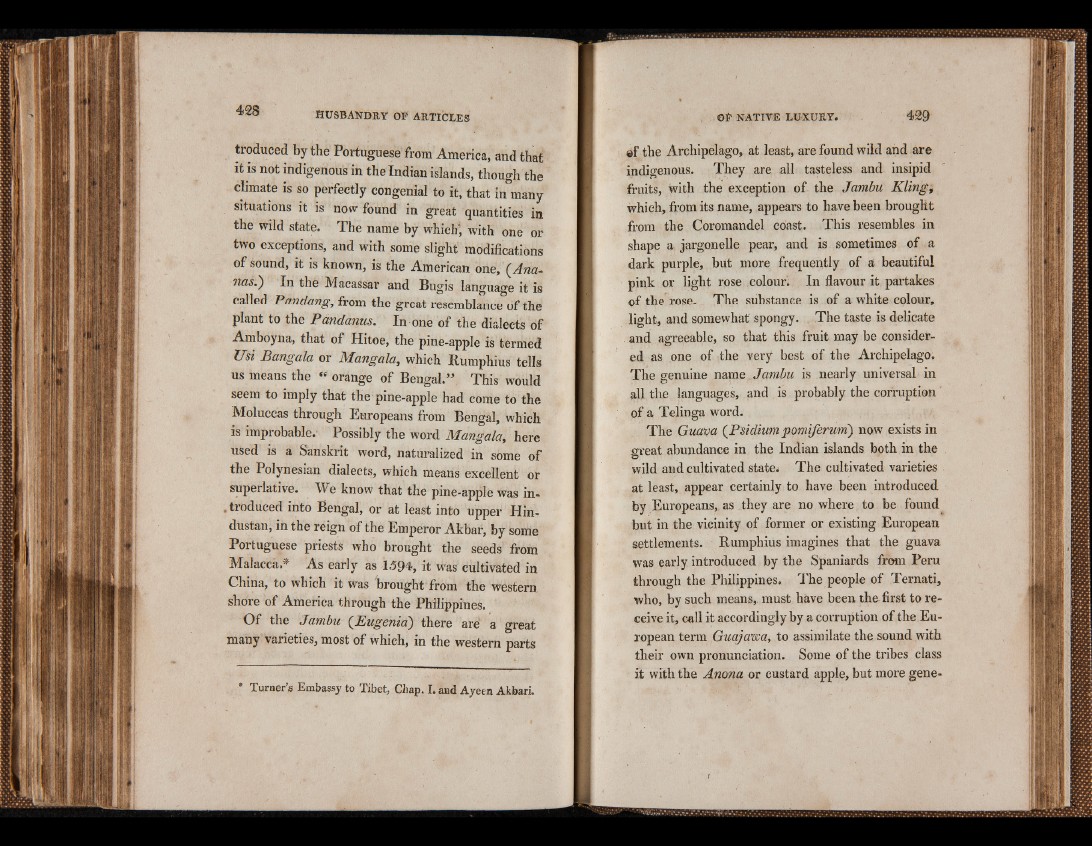
troduced by the Portuguese from America, and that
it is not indigenous in the Indian islands, though the
climate is so perfectly congenial to it, that in many
situations it is now found in great quantities in
the wild state. The name by which*, with one or
two exceptions, and with some slight modifications
of sound, it is known, is the American one, (Ananas.)
In the Macassar and Bugis language it is
called Pandang, from the great resemblance of the
plant to the Pandanus. In one of the dialects of
Amboyna, that of Hitoe, the pine-apple is termed
Z7si Pangala or Mangala, which Rumphius tells
us means the *e orange of Bengal.” . This would
seem to imply that the pine-apple had come to the
Moluccas through Europeans from Bengal, which
is improbable." Possibly the word Mangala, here
used is a Sanskrit word, naturalized in some of
the Polynesian dialects, which means excellent or
superlative. We know that the pine-apple was in-
i ced into Bengal, or at least into upper Hindustan,
in the reign of the Emperor Akbar, by some
Portuguese priests who brought the seeds from
Malacca.* As early as 1594-, it was cultivated in
China, to which it was brought from the western,
shore of America through the Philippines.
Of the Jambu (Eugenia) there are" a great
many varieties, most of which, in the western parts
* Turner’s Embassy to Tibet, Cliap. I. and Ayeen Akbari.
©f the Archipelago, at least, are found wild and are
indigenous. They are all tasteless and insipid
fruits, with the exception of the Jambu Kling,
which, from its name, appears to have been brought
from the Coromandel coast. This resembles in
shape a jargonelle pear, and is sometimes of a
dark purple, but more frequently of a beautiful
pink or light rose colour! In flavour it partakes
of the rose. The substance is of a white colour,
light, and somewhat spongy. The taste is delicate
and agreeable, so that this fruit may be considered
as one of the very best of the Archipelago.
The genuine namq Jambu is nearly universal in
all the languages, and is probably the corruption
of a Telinga word.
The Guava (Psidium pomiferum) now exists in
oreat abundance in the Indian islands both in the
wild and cultivated states The cultivated varieties
at least, appear certainly to have been introduced
by Europeans, as they are no where to be found
but in the vieinity of former or existing European
settlements. Rumphius imagines that the guava
was early introduced by the Spaniards from Peru
through the Philippines. The people of Ternati,
who, by such means,, must have been the first to receive
it, call it accordingly by a corruption of the European
term Guaja'wa, to assimilate the sound with
their own pronunciation. Some of the tribes class
it with the Anona or custard apple, but more gene